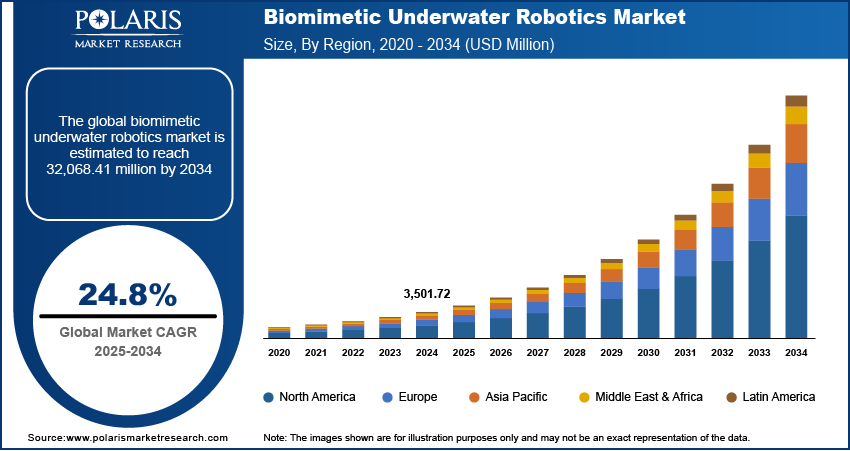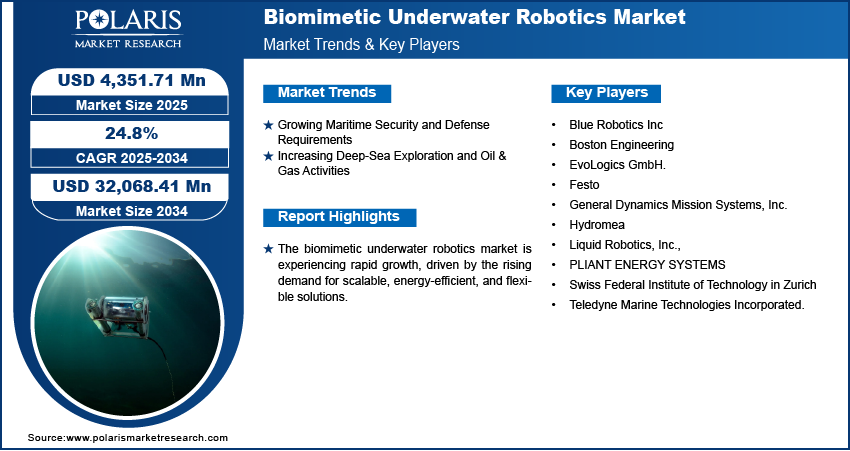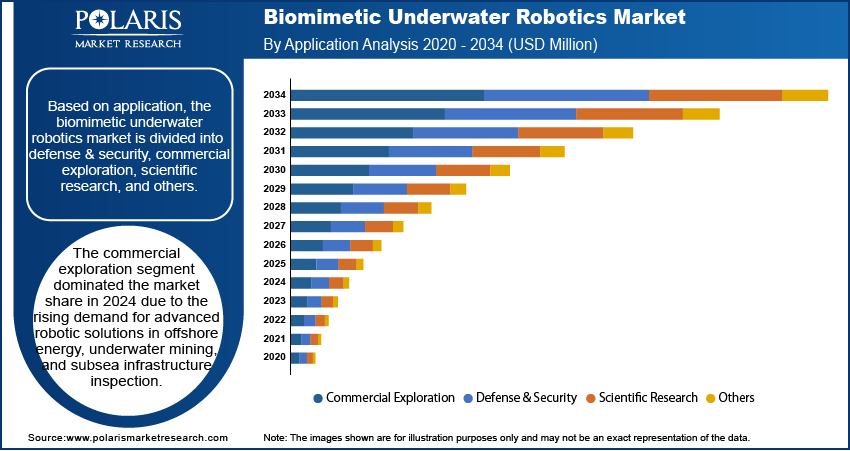
Biomimetic Underwater Robotics Market Size, Share, Trends, Industry Analysis Report: By Type, Component, Application (Defense & Security, Commercial Exploration, Scientific Research, and Others), and Region (North America, Europe, Asia Pacific, Latin America, and Middle East & Africa) – Market Forecast, 2025–2034
- Published Date:Apr-2025
- Pages: 129
- Format: PDF
- Report ID: PM5553
- Base Year: 2024
- Historical Data: 2020-2023
Biomimetic Underwater Robotics Market Overview
The global biomimetic underwater robotics market was valued at USD 3,501.72 million in 2024. It is expected to grow from USD 4,351.71 million in 2025 to USD 32,068.41 million by 2034, at a CAGR of 24.8% during 2025–2034.
Biomimetic underwater robotics refers to robotic systems designed to mimic the movement, behavior, and adaptability of marine organisms to improve underwater exploration and operations. The increasing focus on ocean research, environmental monitoring, and defense applications has driven the demand for these advanced robotic systems. A key driver in this market is the rising demand for autonomous underwater vehicles (AUVs) in marine research. AUVs equipped with biomimetic designs offer improved maneuverability, efficiency, and stealth. They are ideal for deep-sea exploration, habitat mapping, and environmental monitoring as marine ecosystems face increasing threats from climate change, pollution, and resource exploitation. In April 2022, Elwave collaborated with Fugro to integrate a subsea electromagnetic sensor into the Blue Volta eROV, improving DoB surveys by detecting non-ferromagnetic objects while preserving ROV maneuverability. These advancements improve data collection and operational efficiency in complex underwater environments, driving their adoption across scientific and industrial applications.

To Understand More About this Research: Request a Free Sample Report
Technological advancements in artificial intelligence (AI) and materials science accelerate the biomimetic underwater robotics market growth. AI-powered navigation and control systems enable autonomous decision-making, real-time adaptability, and enhanced mission efficiency, reducing the need for human intervention in hazardous underwater conditions. In November 2023, QYSEA Technology launched the FIFISH E-GO, a new underwater robot with a modular design and advanced AI capabilities for versatile subsea operations. Meanwhile, innovations in materials science, such as flexible and lightweight bio-inspired materials, improve the durability, efficiency, and functionality of underwater robots. These advancements enable robots to replicate the movement and structural characteristics of marine life with greater precision, expanding their applications across defense, offshore energy, and environmental monitoring. The integration of AI and advanced materials continues to refine biomimetic underwater robotics, making them increasingly viable for complex and long-duration missions.
Biomimetic Underwater Robotics Market Dynamics
Growing Maritime Security and Defense Requirements
Biomimetic designs enable underwater robots to operate with stealth and agility, mimicking marine life to avoid detection while gathering intelligence in sensitive areas. Their ability to navigate complex underwater environments, conduct survey missions, and detect potential threats makes them a crucial asset for modern naval operations, further boosting the biomimetic underwater robotics market expansion. Additionally, the integration of artificial intelligence (AI) and advanced sensor technologies improves their autonomy, allowing real-time data collection and threat analysis with minimal human intervention. In June 2024, the US Navy and DIU launched Project AMMO to improve underwater threat detection, reducing ML model update times from six months to days. This advancement supports unmanned underwater vehicles and enables scalable AI in defense. Thus, as geopolitical tensions and security challenges rise, the adoption of biomimetic underwater robotics is expected to grow, supporting military and defense strategies worldwide.
Increasing Deep-Sea Exploration and Oil & Gas Activities
The increasing demand for deep-sea mapping, subsea infrastructure inspection, and resource exploration has led to the development of robotic systems capable of navigating extreme depths with enhanced stability and precision. Biomimetic underwater robots, inspired by marine species, offer superior hydrodynamics, energy efficiency, and maneuverability, making them ideal for long-duration deep-sea exploration missions in harsh underwater conditions. For instance, in May 2021, NOAA’s Okeanos Explorer tested Orpheus, an autonomous underwater vehicle (AUV) developed by WHOI and NASA’s JPL. Using vision-based navigation (xVIO), Orpheus maps seafloor features to navigate and explore extreme depths. This technology, inspired by Mars rover systems, aims to advance ocean exploration and prepare for extraterrestrial ocean missions. These robots facilitate pipeline inspections, environmental assessments, and offshore asset monitoring, reducing operational risks and improving data accuracy. Therefore, as offshore energy production expands and deep-sea exploration becomes more critical, biomimetic underwater robotics market size will play an increasingly vital role in advancing subsea operations.

Biomimetic Underwater Robotics Market Segment Insights
Biomimetic Underwater Robotics Market Assessment by Application Outlook
The global biomimetic underwater robotics market segmentation, based on application, includes defense & security, commercial exploration, scientific research, others. The commercial exploration segment dominated the biomimetic underwater robotics market expansion in 2024 due to the rising demand for advanced robotic solutions in offshore energy, underwater mining, and subsea infrastructure inspection. Industries such as oil & gas, renewable energy, and aquaculture are increasingly leveraging biomimetic underwater robots for efficient deep-sea exploration, asset monitoring, and maintenance. These robots offer superior mobility, energy efficiency, and adaptability to harsh underwater conditions, enabling cost-effective and safer operations compared to conventional underwater vehicles. Additionally, the integration of AI-driven navigation and real-time data acquisition improves operational accuracy, further driving adoption in commercial applications. Therefore, as industries continue to expand their underwater operations, the biomimetic underwater robotics market demand in commercial exploration remains strong.
Biomimetic Underwater Robotics Market Evaluation by Type Outlook
The global biomimetic underwater robotics market segmentation, based on type, includes fish-inspired robots, cephalopod-inspired robots, marine mammal-inspired robots, crustacean-inspired robots, ray-inspired robots, others. The fish-inspired robots segment is expected to witness substantial biomimetic underwater robotics market growth during the forecast period due to its superior hydrodynamic efficiency, movability, and adaptability in diverse underwater environments. They are designed to replicate the swimming patterns of fish, these robots experience reduced drag and improved propulsion, allowing for efficient movement in deep-sea and shallow-water applications. Their agility and stealth capabilities make them ideal for applications in scientific research, commercial exploration, and defense operations. Furthermore, continuous advancements in bio-inspired propulsion systems and flexible materials have improved their performance, making them more effective for long-duration missions. Thus, as demand for highly efficient and autonomous underwater systems grows, fish-inspired robots are poised to play a crucial role in the biomimetic underwater robotics market expansion.

Biomimetic Underwater Robotics Market Regional Analysis
By region, the report provides the biomimetic underwater robotics market insights into North America, Europe, Asia Pacific, Latin America, and the Middle East & Africa. Europe dominated the biomimetic underwater robotics market revenue in 2024, driven by investments in marine research, defense modernization, and offshore energy projects. The region’s well-established maritime industry, combined with strong government support for underwater robotics innovation, has accelerated the adoption of biomimetic technologies. For instance, in December 2024, the European Investment Bank launched the EU Blue Champions Programme to support 20 innovative blue economy companies, including Swedish electric boat maker X Shore, with a USD 15.49 million investment strategy to promote sustainable ocean growth and marine technologies such as underwater robotics. European nations have been at the forefront of integrating these advanced robotic systems for environmental monitoring, deep-sea exploration, and naval surveillance, improving operational capabilities across multiple sectors. Additionally, collaborations and investments between research institutions, defense agencies, and commercial enterprises have boosted technological advancements, further strengthening Europe's position in the market. For instance, In January 2021, ELWAVE received USD 2.12 million from the European Commission to commercialize its "electric sense" technology, providing 360° detections for underwater vehicles and robotics to improve safety and productivity. The region’s focus on sustainability and ocean conservation has also contributed to the growing deployment of biomimetic underwater robotics for ecological studies and marine resource management.
The biomimetic underwater robotics market size in Asia Pacific is projected to witness substantial growth during the forecast period due to increasing investments in marine security, deep-sea exploration, and offshore infrastructure development. Countries in the region are expanding their naval capabilities and underwater defense systems, creating a strong demand for biomimetic robots in management and surveillance operations. Additionally, the rapid growth of the offshore energy sector, particularly in oil & gas and renewable energy, is driving the adoption of advanced robotic systems for subsea inspection and maintenance. Research initiatives in marine biodiversity and environmental monitoring further support biomimetic underwater robotics market expansion, as biomimetic robots offer an efficient means of studying complex underwater ecosystems. Thus, Asia Pacific is expected to emerge as a key market for biomimetic underwater robotics in the coming years with continuous advancements in robotics and artificial intelligence.

Biomimetic Underwater Robotics Market – Key Players & Competitive Analysis Report
The competitive landscape is characterized by a mix of global leaders and regional players aiming to capture biomimetic underwater robotics market share through innovation, strategic collaborations, and geographic expansion. Global players such as Boston Engineering, EvoLogics GmbH, Festo, and others leverage strong R&D capabilities and extensive technological expertise to develop advanced biomimetic robots that mimic marine organisms such as fish, octopuses, and jellyfish. These robots are designed for applications such as underwater exploration, environmental monitoring, defense, and infrastructure inspection. Biomimetic underwater robotics market trends indicate a rising demand for energy-efficient, autonomous, and highly moveable robotic systems driven by advancements in materials science, artificial intelligence, and bio-inspired design. According to biomimetic underwater robotics market statistics, the market is projected to experience substantial growth, fueled by increasing applications in marine research, offshore energy, and military operations. Biomimetic underwater robotics market competitive strategies such as mergers and acquisitions, partnerships with research institutions and defense organizations, and the development of innovative products are tailored to specific industry needs. These developments highlight the importance of technological innovation, market adaptability, and strategic investments in driving the growth of the biomimetic underwater robotics industry. A few key major players are Boston Engineering; Festo; Hydromea; Liquid Robotics, Inc.; EvoLogics GmbH; General Dynamics Mission Systems, Inc.; Swiss Federal Institute of Technology in Zurich; Teledyne Marine Technologies Incorporated; PLIANT ENERGY SYSTEMS; Blue Robotics Inc.
Liquid Robotics, Inc. is an American marine robotics corporation that specializes in designing and manufacturing unmanned surface vehicles (USV). Founded in 2007, the company is now located in Herndon, Virginia. Liquid Robotics is a wholly-owned subsidiary of The Boeing Company and part of Boeing’s defense, space, and security organization. The company is known for its wave glider, a wave and solar-powered autonomous vehicle that can harvest energy from ocean waves for propulsion, allowing it to stay at sea for extended periods, collecting and transmitting ocean data. The wave glider consists of a surface float and a submerged section connected by a rope. It harnesses the motion difference between the ocean surface and calmer waters below to move without fuel. Solar panels on the float recharge batteries to power sensors, communications, and navigation systems. The vehicle can be operated autonomously or remotely via various links. Liquid Robotics wave gliders are used across government, defense, scientific, commercial, and industrial sectors for ocean observation, data collection, and environmental monitoring.
Pliant Energy Systems is a company that focuses on creating innovative technologies in areas such as marine robotics, propulsion, electricity generation, and pumping. Their engineering approach involves bladeless interactions with fluids, utilizing undulating surfaces instead of traditional spinning propellers or turbines. This has led to the development of technologies with applications in defense, marine propulsion, ocean exploration, renewable energy, and water management. Pliant Energy Systems robots utilize an undulating propulsion system, drawing inspiration from animal locomotion. Their robots employ unique "fins" that enable them to swim like a ray, crawl like a millipede, jet like a squid, and slide like a snake. This design allows for versatile movement through different environments, making the robots suitable for tasks such as coral reef inspection, sea mine inspection, and pipeline scanning. The robots are also designed to be resistant to entanglement in aquatic plants, minimizing environmental impact. The company has received funding through federal and state grants and contracts from organizations such as the US Office of Naval Research, the Department of Energy, and the National Science Foundation.
List of Key Companies in Biomimetic Underwater Robotics Market
- Blue Robotics Inc.
- Boston Engineering
- EvoLogics GmbH.
- Festo
- General Dynamics Mission Systems, Inc.
- Hydromea
- Liquid Robotics, Inc.,
- PLIANT ENERGY SYSTEMS
- Swiss Federal Institute of Technology in Zurich
- Teledyne Marine Technologies Incorporated
Biomimetic Underwater Robotics Industry Development
March 2022: Verlume and its partners developed robotic fish to improve offshore inspection protocols, improving the efficiency of inspections for submerged infrastructure in marine environments.
Biomimetic Underwater Robotics Market Segmentation
By Type Outlook (Revenue, USD Million, 2020–2034)
- Fish-inspired Robots
- Cephalopod-inspired Robots
- Marine Mammal-inspired Robots
- Crustacean-inspired Robots
- Ray-inspired Robots
- Others
By Component Outlook (Revenue, USD Million, 2020–2034)
- Sensors & Navigation Systems
- Control & Power Systems
- Communication Systems
- Advanced Software Systems
- Others
By Application Outlook (Revenue, USD Million, 2020–2034)
- Defense & Security
- Commercial Exploration
- Scientific Research
- Others
By Regional Outlook (Revenue, USD Million, 2020–2034)
- North America
- US
- Canada
- Europe
- Germany
- France
- UK
- Italy
- Spain
- Netherlands
- Russia
- Rest of Europe
- Asia Pacific
- China
- Japan
- India
- Malaysia
- South Korea
- Indonesia
- Australia
- Vietnam
- Rest of Asia Pacific
- Middle East & Africa
- Saudi Arabia
- UAE
- Israel
- South Africa
- Rest of Middle East & Africa
- Latin America
- Mexico
- Brazil
- Argentina
- Rest of Latin America
Biomimetic Underwater Robotics Market Report Scope
|
Report Attributes |
Details |
|
Market Size Value in 2024 |
USD 3,501.72 million |
|
Market Size Value in 2025 |
USD 4,351.71 million |
|
Revenue Forecast in 2034 |
USD 32,068.41 million |
|
CAGR |
24.8% from 2025 to 2034 |
|
Base Year |
2024 |
|
Historical Data |
2020–2023 |
|
Forecast Period |
2025–2034 |
|
Quantitative Units |
Revenue in USD Million and CAGR from 2025 to 2034 |
|
Report Coverage |
Revenue Forecast, Market Competitive Landscape, Growth Factors, and Industry Trends |
|
Segments Covered |
|
|
Regional Scope |
|
|
Competitive Landscape |
|
|
Report Format |
|
|
Customization |
Report customization as per your requirements with respect to countries, regions, and segmentation. |
FAQ's
The global biomimetic underwater robotics market size was valued at USD 3,501.72 million in 2024 and is projected to grow to USD 32,068.41 million by 2034.
The global market is projected to register a CAGR of 24.8% during the forecast period.
Europe dominated the market share in 2024.
A few of the key players in the market are Boston Engineering; Festo; Hydromea; Liquid Robotics, Inc.; EvoLogics GmbH; General Dynamics Mission Systems, Inc.; Swiss Federal Institute of Technology in Zurich; Teledyne Marine Technologies Incorporated; PLIANT ENERGY SYSTEMS; and Blue Robotics Inc.
The commercial exploration segment dominated the market share in 2024.
The fish-inspired robots segment is expected to grow at a robust pace in the coming years.
